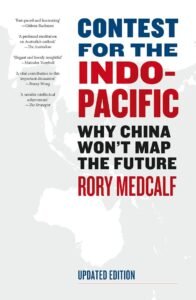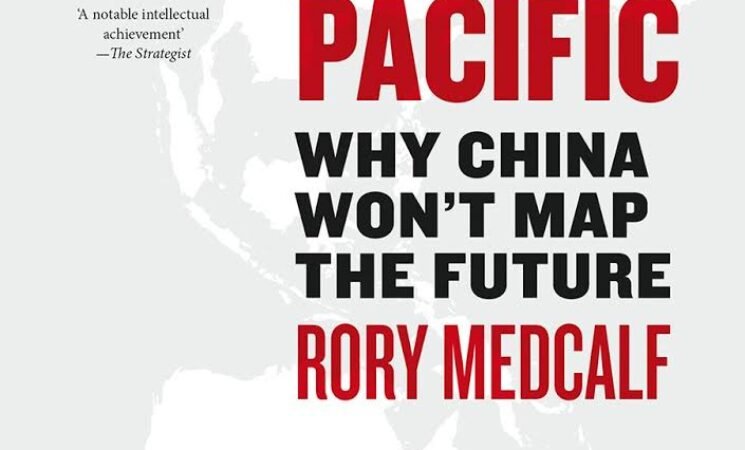Rory Medcalf (2020), Contest for the Indo-Pacific: Why China Won’t Map the Future, La Trobe University Press.
Anshu Kumar
 Akin to the usage of ‘Cold War’ during the second half of the twentieth century, the term ‘Indo-Pacific’ has emerged as a desideratum at scholars’ colloquium, foreign policy brass, military establishment, and minilateral to multilateral gatherings. The term represents the changing dynamics of international politics. The very term has reached such orthodoxy that deferring to use it would cause angst about being left out in a new geopolitical race. For Rory Medcalf; who has a motley of experience in diplomacy, think tanks, academia, journalism, and strategic and intelligence analysis for over three decades; the concept evinces power relations among several players informed by the interplay of economy, strategy and geography.
Akin to the usage of ‘Cold War’ during the second half of the twentieth century, the term ‘Indo-Pacific’ has emerged as a desideratum at scholars’ colloquium, foreign policy brass, military establishment, and minilateral to multilateral gatherings. The term represents the changing dynamics of international politics. The very term has reached such orthodoxy that deferring to use it would cause angst about being left out in a new geopolitical race. For Rory Medcalf; who has a motley of experience in diplomacy, think tanks, academia, journalism, and strategic and intelligence analysis for over three decades; the concept evinces power relations among several players informed by the interplay of economy, strategy and geography.
Medcalf’s Contest for the Indo-Pacific: Why China Won’t Map the Future is a significant addition to the scholarship of the Indo-Pacific. The ‘Indo-Pacific’ is not simply a buzzword, it delineates an altering approach of states to security, diplomacy, and prosperity marked by the integration of the Pacific and the Indian Ocean on several cross-cutting cleavages. For Medcalf, ‘mental maps’ are crucial as the explicit marking of the map leads to a clairvoyance in the prioritization of goals and allocation of resources to such ends. However, he warns against depicting the concept using the ‘false’ Sino-American binary. He assumes a central role to be played by the middle powers in navigating this mega-region. Unlike several scholars, who define the arena as everything but multipolar, he considers the region to be ‘many-sided’ or ‘multipolar’— an arena of multiple players interacting at multiple layers. However, an explicit conceptual definition of ‘multipolarity’ and ‘middle powers’ is wanting in his analysis.
Commendably, this work is informed by a historical odyssey which demonstrates the presence of an integrated two-ocean space, since time immemorial, marked by the flow of trade, culture, religion, and people. The author reveals that the Europeans did not invent the concept of an integrated Indo-Pacific region. At the outset of their imperial voyages to Asia, they came across an already interwoven latticework of ‘maritime societies’. It was the Cold War and co-incident inward-looking India and China that helped to pigeonhole Asia into various compartments— South Asia, East Asia, Southeast Asia, and others. Likewise, the jargon ‘Asia-Pacific’ has its recent genesis. This wider Indo-Pacific region has a long pedigree marked by cooperation, coexistence, competition, confrontation and conflict— a harbinger of modern-day struggle for this region.
From Thomas Mitchell’s diagonally tilted map in 1848 to Chinese cartographer Hao Xiaohuang’s recent Asia-focused map, the regional players have endeavoured to carve a central role for themselves in this ever-existing maritime space. Though China may be averse to using the ‘Indo-Pacific’ term in its official pronouncements, its economic, political, and military juggernaut across the region and beyond belies such decry. Notably, a parallel can be drawn between Zhu Di, the third Ming Ruler who sent intrepid and extravagant naval expeditions to legitimise his forceful ruling over China, and Xi Jinping’s ambitious Belt and Road Initiative (BRI) to vindicate the Communist Party of China’s (CCP) grip over Chinese society. The author claims that BRI has, to a large extent, colonial underpinnings. At the same time, the author unearths a unified propaganda history propagated by modern-day China which posits the historical centrality of China in Asia and the wider region. Upon excavating, he situates India and its eponymous ocean as the centre of gravity in the region, historically. Instead of being Sino-centric, the ancient ‘Silk Road’ had sundry belts and roads, and several centres of power.
Today the Indo-Pacific is gravitating as the pivot of the globe in terms of trade, population and, military mobilisation. This region is marked by the juxtaposition of commercial shipping, which lulls one to believe in a borderless world, and military fleets, which reify the existing sovereignty, boundaries, and the use of force. Control and safety of shipping lanes, ports, and choke points have become increasingly salient for the prosperity and subsequent political stability and security of nations in this region. Thus, wealth and power are cross-cutting. As a consequence, this region is witnessing gathering storms with the arms race, development of undersea capabilities, nuclear threats, and latent flashpoints for massive conflagration. Although China is one of the main drivers of this region, the future would be pronounced by many.
The author drifts from the ‘power as resources’ concept. For him, states are not billiard balls interacting in the abstract. Instead, an inside-out approach to read the states’ behaviour is more apt as similar states respond differently to their external settings, mediated by multiple variables such as leaders’ personalities, political systems, ideologies, cultures, and others. Though players interact on a continuum from cooperation, at one end, to conflict, at another; in certain situations competition supplants cooperation, ultimately leading to conflict. Since China may not have the luxury to moderate its external behaviour (as its revisionist tendencies flow from a need to vindicate CCP’s rule, manage internal problems, and maintain domestic social stability), full-fledged cooperation with China may seem to be a chimera. Hence, to reinforce predictability and stability under conditions of mistrust, Medcalf suggests a less ambitious starting point for cooperation— ‘competitive coexistence’. It is about maintaining healthy competition while disincentivizing outright confrontation and resorting to coexistence when required.
He comes up with several fair suggestions, such as confidence-building measures (CBMs), solidarity, resilience and others, to manage this multi-pronged game in the Indo-Pacific. He acknowledges that diplomacy works only complementarily to force and states need enhanced conventional military capabilities, advanced technologies, and geoeconomic resilience to deter or socialize China in holding the threshold. A reflection of his diplomatic career can be found in his utmost belief in the collective agency of middle players and assiduously calibrated diplomacy to augment ‘solidarity’ against the aggressor. His belief in the concerted efforts of small and middle powers to deter and punish giants like China seems to flow from the ‘power as outcome’ approach. However, it overestimates the collective façade, even absent that of superpowers like the US, of middle powers to confront a belligerent China. Several middle states would have difficulty establishing collective informal norms to communicate the costs to China. Various states remain invariable hedgers and refrain from approaching the region in white and black i.e. treating one great power as an invariable foe and another as an all-weather partner. The historical imprints make states like India, Vietnam, Indonesia, and others equally sceptical of any great powers in the region. Moreover, geographic proximity aids in their hedging propensities. Thus, they strive for multi-alignment or sometimes what is called ‘strategic autonomy’.
Nevertheless, this book takes a moderate approach to dealing with multiple actors on disparate issues. Rather than outright containment or accommodation, the author calls for ‘conditional engagement’— accepting China as a legitimate player in the region but preparing for more active balancing and coordinated solidarity if engagement collapses. Interestingly, he seeks to forgo the unnecessary dichotomy of economy versus security—the misbelief that a response to Chinese economic coercion can have security fallouts — in dealing with China. This mega-region would not be mapped by China or the US alone for the region is too vast for any single power to dominate. China’s internal shackles and external overextension make it vulnerable and undermined in the long run. This gargantuan region is meant to protect the vital interests of actors and to draw strength from collective action, self-help, and mutual help. This book is a must for those who want to soak themselves in an enriching expedition of this region through various millennia. This book provides a clear picture of a tousled field of the Indo-Pacific where the term has been frequently used as a buzzword.

